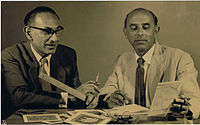- Graphic designer
-
Graphic designer 
Gabriel and Maxim ShamirOccupation Names creative director, art director Activity sectors advertising, book design, branding, illustration, page layout, typography, web design Description Competencies technical knowledge, cultural relevance, art history A graphic designer is a professional within the graphic design and graphic arts industry who assembles together images, typography or motion graphics to create a piece of design. A graphic designer creates the graphics primarily for published, printed or electronic media, such as brochures (sometimes) and advertising. They are also sometimes responsible for typesetting, illustration, user interfaces, web design, or take a teaching position. A core responsibility of the designer's job is to present information in a way that is both accessible and memorable.[1]
Contents
Qualifications
A degree or certificate from an accredited trade school is usually considered essential for a graphic design position. After a career history has been established, though, the graphic designer's experience and number of years in the business are considered the primary qualifications. A portfolio, which is the primary method for demonstrating these qualifications, is usually required to be shown at job interviews, and is constantly developed throughout a designer's career.
One can obtain an AAS, BA, BFA, MFA or an MPhil / PhD in graphic design. Degree programs available vary depending upon the institution, although typical U.S. graphic design jobs require at least some form of degree.
Current graphic designer jobs demand proficiency in one or more graphic design software programs. Arguably, the most common software used in the graphic design industry is Adobe Creative Suite. The "Suite" has three primary programs used by a designer:
- Photoshop -manipulate photos, typography and create images with a variety of effects.
- Illustrator -create logos and typography.
- InDesign -create typography, and output print layouts. (Some designers still prefer QuarkXPress when creating layouts, as it was previously the industry standard choice.)
Outside the graphic design industry many people use Microsoft Word to make a layout or design. However, depending on the job at hand, most designers create the layout in either InDesign or QuarkXPress. Specifically, the designer will type the text in the layout program, importing the graphics and images they created in PhotoShop or Illustrator. There are a couple reasons a designer builds a layout in this fashion:
- Files going to press are printed at 300 dots per inch. As a result, the file size can become very large. So by using a layout program and importing the graphics and images, the working file is a fraction of the file size. When the designer is ready to go to press, they will either create a press-ready PDF; or do what is called, "Collect For Output."
- InDesign or QuarkXpress make it possible to work with large multipage layouts like catalogs and booklets.
- Since InDesign and QuarkXPress import the original file, linking to the graphics and images, the designer can change the "original file" and it will update all instances throughout the document to save time.
A web designer should understand how to work with XML, HTML, and basic web programming scripts. A print designer should understand the processes involved in printing to be able to produce press-ready artwork.Designers should be able to solve visual communication problems or challenges. In doing so, the designer must identify the communications issue, gather and analyze information related to the issue, and generate potential approaches aimed at solving the problem. Iterative prototyping and user testing can be used to determine the success or failure of a visual solution. Approaches to a communications problem are developed in the context of an audience and a media channel. Graphic designers must understand the social and cultural norms of that audience in order to develop visual solutions that are perceived as relevant, understandable and effective.[2]
Graphic designers should also have a thorough understanding of production and rendering methods. Some of the technologies and methods of production are drawing, offset printing, photography, and time-based and interactive media (film, video, computer multimedia). Frequently, designers are also called upon to manage color in different media.[3]
Career portfolio
Fifty years ago, the graphic designer's portfolio was usually a black book or large binder in which samples of the artist's best printed pieces were carried to show prospective clients or employers. Printed pieces are often protected inside by being mounted on boards or slipped into Acetate sleeves.
Since the 1990s, portfolios have become increasingly computer digitized, and now may be entirely digitized and available on the Internet, or on CD, DVD, or via email.
Branding
Graphic design relates heavily to corporate identity, the branding and "persona" of a corporation.
See also
References
- ^ Jessica Helfand. "What is graphic design?". AIGA. http://www.aiga.org/content.cfm/what-is-design. Retrieved 2009-06-29. "it is the art of visualizing ideas"
- ^ NASAD Competencies Summary, BFA in Graphic Design, page 2 agresources.arts-accredit.org, last accessed 29 June 2009.
- ^ NASAD Competencies Summary, BFA in Graphic Design, page 2 agresources.arts-accredit.org, last accessed 29 June 2009.
Categories:- Computer occupations
- Media occupations
- Graphic designers
Wikimedia Foundation. 2010.
